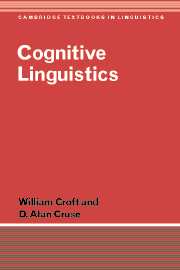Book contents
- Frontmatter
- Contents
- Figures
- Tables
- Preface
- 1 Introduction: what is cognitive linguistics?
- A conceptual approach to linguistic analysis
- Cognitive approaches to lexical semantics
- 5 Polysemy : the construal of sense boundaries
- 6 A dynamic construal approach to sense relations Ⅰ: hyponymy and meronymy
- 7 A dynamic construal approach to sense relations Ⅱ: antonymy and complementarity
- 8 Metaphor
- Cognitive approaches to grammatical form
- References
- Index
- Index
5 - Polysemy : the construal of sense boundaries
Published online by Cambridge University Press: 05 June 2012
- Frontmatter
- Contents
- Figures
- Tables
- Preface
- 1 Introduction: what is cognitive linguistics?
- A conceptual approach to linguistic analysis
- Cognitive approaches to lexical semantics
- 5 Polysemy : the construal of sense boundaries
- 6 A dynamic construal approach to sense relations Ⅰ: hyponymy and meronymy
- 7 A dynamic construal approach to sense relations Ⅱ: antonymy and complementarity
- 8 Metaphor
- Cognitive approaches to grammatical form
- References
- Index
- Index
Summary
Introduction
Polysemy is understood here in a broad sense as variation in the construal of a word on different occasions of use. It will be treated here as a matter of isolating different parts of the total meaning potential of a word in different circumstances. The process of isolating a portion of meaning potential will be viewed as the creation of a sense boundary delimiting an autonomous unit of sense. For instance, in (1), the meaning ‘river bank’ is as it were fenced off from the rest of the word's potential, and presented as the only functionally relevant portion. The fact that bank can also refer to a financial institution is suppressed:
John moored the boat to the bank.
The operative factor in this case is of course the immediate linguistic context. Polysemy is interpreted in this chapter somewhat more broadly than the traditional lexicographic acceptation involving distinct, established senses, but it includes the traditional view as a special, perhaps in some ways prototypical, case.
On the present account, bounded sense units are not a property of lexical items as such; rather, they are construed at the moment of use. (The notion of sense boundaries that are sharp, but subject to construal, distinguishes the present account from that of Cruse 2000, and also from accounts such as Deane 1988 and Geeraerts 1993, which question the existence of boundaries.) When we retrieve a word from the mental lexicon, it does not come with a full set of ready-made sense divisions.
- Type
- Chapter
- Information
- Cognitive Linguistics , pp. 109 - 140Publisher: Cambridge University PressPrint publication year: 2004
- 1
- Cited by

